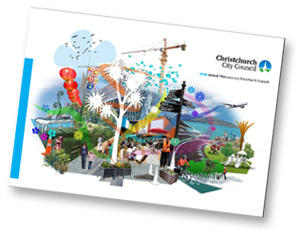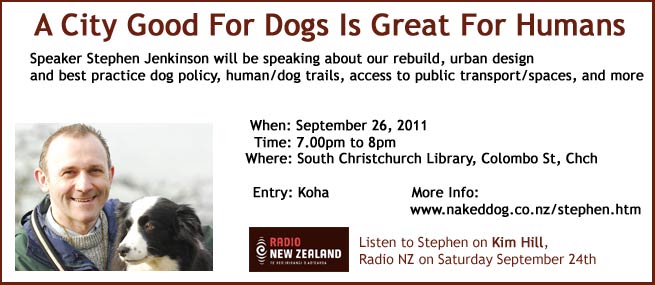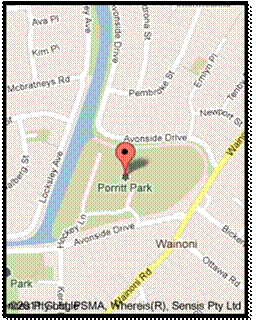Changing Thinking is a Walk In the Park
Many of you will know that we have lost (but still have interim use of) our Wainoni Scout Hall venue due to a late call on red zoning, but post Sept 2010 & Feb 2011 damage to the city owned Canterbury Hockey stadium and its adjacent river surrounds we proposed and submitted to CERA, (Canterbury Earthquake Recovery Authority) CCC (Christchurch City Council) and the CDHB (Canterbury District Health Board) a detailed whole of city concept for dog trails with the fit for purpose park as the hub.
"Barkerton Park" has been scrutinised by many who have applauded the concept and noted the referenced supporting literature and science evidencing the SOCIAL CAPITAL and WELLBEING that comes from recognising and rethinking urban design in a unique city that has twice as many dogs per household as Auckland and three times that of Wellington.

April and until 21st May is your opportunity to contribute to the Christchurch Otautahi 2012-13 Draft Annual Plan.
You may wish to submit your support for the School of the Naked Dog rebuild proposal to repurpose Porrit Park and the existing dog friendly amenities into a whole of city civic project and venue of national and international significance and opportunity we titled "Barkerton Park".
It is a project that Champion of Healthy Christchurch, Professor Hornblow described as "Christchurch needs a Success, Now!". CERA sat on it for six months before emailing us saying it is a CCC issue.
This is our last and only chance to put consultation back into the community....
and crucially, an opportunity for the Garden City to invent itself around the safety and wellbeing, of its citizens, families and its communal space rather than the ten mega-million dollar 'bricks and mortar' CBD based "Major Projects" that have been the focus these past 18 months.
The benefits are highly indicated and the work and money required minimal. The speed of implementation is paramount, needed now and not difficult at all. We call it a rates neutral, quick return, evidence based inter generational equity by bottom up design.
Further inquiries welcomed. A site visit and project presentation is planned. You can see the whole proposal as a PDF File or read it below
A healthier Christchurch starts at
Barkerton Park
A Healthy Addition, and a Quick Success for Rebuilding, An EARLY WIN
A Community Opportunity, starting One Dog Owner at a time
Comment and Feedback in respect of the Draft Recovery Strategy
“Land, Building and Infrastructure Recovery Plan What? This plan identifies where, when and how rebuilding can occur; timeframes for making decisions about whether land can be remediated, and a process and timeframe for land remediation; a methodology for reviewing existing national, regional and local strategies and plans; programmes and sequencing of areas for rebuilding and development; a spatial plan for housing and strategic infrastructure and community facilities to maintain the short-term wellbeing of communities, long-term recovery and growth aspirations; a framework for identifying investment priorities and opportunities for horizontal, strategic and community infrastructure; and identification and prioritisation of ‘early-win’ projects.” pp.28-29 of Stronger Christchurch
Of all the biopsychosocial parameters we have captured since the quake, the one most missed may well be the game changer for East Christchurch, the River Park and Greater Christchurch.
What characterizes a city challenged with the displacement of entire communities?
Where do they go and why?
What might we have we missed as we work towards
“Making Place” out of what we have?
Consider:
In trying to turn High Street into one of the great public spaces in Australia, the first thing I did was organise a weekly Friday night event during the summer called ‘Lounging on High’. We put some old retro lounge chairs in the street, hired a jazz band and invited people to bring food and drink and ‘lounge on High’. Because many people lounge at home with their pets, we put out dog drinking bowls to encourage people to bring their dogs. When we eventually rebuild High Street it will include dog drinking bowls and hitching rails.
In place making, dogs play a much greater role than just ‘conversation starter’ or ‘social lubricant’. One of the secrets of place making is to get people to slow down. If people take twice as long to get from A to B, the street will look twice as full, without attracting a single extra customer. A street full of people is more appealing than a street half empty. So when people stop to pat a dog or chat to the owner, they are actually helping to bring the street to life.
As a place maker, my job is to deliver a memorable experience. Dogs can help create that memorable experience for many people, especially for children.
In Living Well Together you will find lots of case studies of how cities, towns and neighborhoods are using pets to improve the wellbeing of communities and build social capital. It is a timely reminder that we often think that creating great places, great streets and great parks requires big, expensive plans, when in fact, it is the simple things that help us live well together.
DAVID ENGWICHT
Former CBD Place Maker for City of Wodonga
Christchurch has twice as many dogs per household as Auckland and three times more than Wellington.
Blair Anderson
Dogs, Dogs and More Dogs
We are a “Dog City” at the hub of a Country built on the back of the Dog.
Christchurch rebuild discussions to date has missed  something that encapsulates that which can be defined as integral to Our Character, Our Heritage and our Life Style.
something that encapsulates that which can be defined as integral to Our Character, Our Heritage and our Life Style.
Could it be what the good Doctor ordered?
(see Dr Lisa Wood, Centre for the Built Environment and Health, School of Population Health, University of Western Australia “Living Well Together” – How Companion Animals can help Strengthen Social Fabric.)
“Research in the last few decades is proving what we’ve always known anecdotally – pets aren’t just good, they’re actually good for us. We now know that pets can help improve our quality of life; they can reduce stress, improve health and provide much-needed companionship. Pets also encourage people to enjoy the outdoors, stimulate conversations between strangers and improve our feelings of safety.”-http://www.petsinthecity.net.au/sites/default/files/pets_in_the_city.pdf
Should we engage with and ask the Champions of Healthy Christchurch, what would characterize a healthy city better than ‘for all its dogs’ – applying best practice all of city pet friendly urban design, and what that insight brings to the solution space and to informing what will work better for everyone.
It should be recommended reading for everyone who can make a difference to the health and well-being of individuals and communities – so not just health professionals and community workers, but also planners, engineers, architects, developers, councils and governments, even individuals. Why? It shows what’s possible when we work together with commitment, passion and a determination to make a difference.
The focus of the Handbook is pets and how they contribute to social capital. This emphasis on social capital goes to the heart of the Healthy Spaces and Places project. Healthy Spaces and Places is a national [aus] approach that recognises the influence the spaces and places we build for living, working and playing (the built environment) can have on our lifelong health.
- ANNE MORONEY, Project Manager, Healthy Spaces and Places Project.
DOG WALKING AND PHYSICAL HEALTH
Walking and physical activity is strongly linked to improved general health and lower risks of obesity, heart disease and blood pressure problems. Many studies now associate pets, and particularly dogs with increased levels of physical activity. Australian research indicates that not only do dogs motivate their owners to walk more
often and meet recommended levels of physical activity; but also that children who own dogs are less likely to become overweight or obese.With obesity also a growing problem among the pet population36 dogs themselves stand to benefit. In the “Dog Ownership can address obesity epidemic” case study, Dr Jo Salmon reports on studies the physical benefits that children harness from owning dogs.
MENTAL AND SOCIAL HEALTH
There is increasing evidence of the benefits that physical activity has on mental health and wellbeing.37 Walking for example, can provide contact with nature which can be restorative, provide stress relief and be beneficial to mental health.Similarly, it also provides opportunities for informal contact with others.
More people and dogs out walking, combined with an increase in regular walks, can further a sense of safety in the communitywhile well exercised dogs are less likely to behave anti-socially.All of which is critical in building and maintaining community cohesion, pride, and social capital. This in turn has been linked to better general health, lower mortality rates,positive child developmentand less violent crime.
- The “A Sense of Safety…” case study explores the way in which dogs and dog walking promote a sense of safety in the community.
Physicians and other health care providers can play a unique and integral role in promoting physical activity among patients by recommending dog walking both to dog owners and to non-dog owners as a purposeful, enjoyable, and sustainable form of regular physical activity.
– Current Sports Medicine Reports:: July 2011 - Volume 10 - Issue 4 - pp 224-227
So! Did we miss something?
This writers ‘alert’ to the strategists and analysts considering what we should and could be doing around our rebuild is also to alert that when it comes to the stuff that is easy to deliver, the hard work has largely been done, all that needs doing is distribution of the rich body of ‘design’ content back into such organisations as the Institute of Architects, to the Champions of Healthy Christchurch and of course – crucially our Developers/Investors, Councilors and the Public by way of support for sustainable community concepts embodied within this feedback.
Support for the opportunity in the Barkerton Park design principals and a civic approach to highly integrated ‘pet friendly’ approach that is possible within the new transport options, Riverside Park, the CBD, and in people friendly urban development.
Internationally regarded town planner, Virginia Jackson, delivers a set of contemporary housing design guidelines that considers the valuable role that companion animals that play in our domestic lives.
Should we ask CCC Animal Control what education and deliverables would be utopia in a city Dog Park set amongst a riverside park?
Should we integrate Human/Dog Activity Trails in a urban setting?
The answer of course is yes we should ask these questions?
Let's look at some of the evidence.
Building Community
- Community comes together and educates through fun family activity
- Dog park interaction creates community links
- Local support networks, activities and advice developed online
- An opportunity for community joy and connectedness through Blessing of the Animals
- Community connections created through local parties for owners and pets
Healthy Communities
- Dog ownership can address obesity epidemic
- Physical activity and responsible dog ownership promoted through Council walking group
- Planned events promotes benefi ts of walking for dogs and people
- Sense of safety strengthened through dogs at home and on the street
A Place for All
- Progressive pet friendly developments
- Dog friendly policies can be good for business
- Animal shelter vouches for adoptee pets in rental accommodation
- Community contact promoted through dog parks and coffee culture
- Pet friendly policies for the workplace foster happy staff and happy pets
- Pet friendly accommodation
- Retirement accommodation successfully plans for pets
Doing the Right Thing
- Public open space can facilitate social interaction
- Alliance between local government and dog owners delivers long-term benefits to both
- Combined Councils’ watch-dog project reduces dog waste
- Opportunity to build community through free dog training
- Councils partner with local dog walkers to deliver widespread community benefits
- Unleashing healthy lifestyles in local areas
Making the Most of What You’ve Got
- Gold Coast program delivers exercise, information and social interaction
- Dog agility area delivers big benefi ts to pets and owners
- Social barriers broken down via pet program that supports older and disabled people
- Saving the lives of animals is life enhancing
- Community spirit lifted and euthanasia rates reduced
- Frail and elderly maintain beloved pets with help from community
Catering to All
- New approach improves dog health in Indigenous communities
- Pets in healthcare prove to be key motivators in recovery
- Simple support steps can make a difference
- Assistance animals ensure mobility and independence for people with special needs
- Assistance dogs enhance quality of life for those on the outer
- In home volunteer pet care programs provides elderly with independent living and stress relief
- Pulling it all together
Excerpted from Dr Lisa Wood’s topic index.
But foremost in this submissions is the identified opportunity to take action quickly, invest in what is broken and turn it into part of the solution. [“And we surely need a success story, now!” - Professor Hornblow.]
PROPOSAL
The writer proposes a private/public partnership to repair, restore and make good the facilities at Porritt Park and its environment, in Wainoni, East Christchurch.
That this concept, "Barkerton Park" becomes a locus and hub for dog trail activities across the new new, green space (Avon/Otakaro River Park) and fulfills in the broadest sense the beneficent advantages detailed in the accompanying three reports including but not limited to delivery of important national academic social policy research (Canterbury University, Lincoln has confirmed interest), international and national canine activities, including conventions, seminars, policy education, competition and exemplar facilitation of training and related services back to the community.
A Museum of Dog and learning center operating co-operatively with schools for all things dog could also be a value added future function. Especially of interest to the writers is supporting the emerging science and efficacy of Dogs as companion animals for a wide range of service functions beyond sight and hearing assistance.
The School of the Naked Dog already promotes and delivers the successful youth targeted bite prevention program "Doggone Safe" throughout New Zealand.
The Earthquake damaged Porritt Park (so named after Sir Arthur Porritt, Governor General and the third man in "Chariots of Fire" – Paris Olympics, 1924) has a Canterbury dog connection that can be honored and retained notably the unveiling of the iconic McKenzie's Dog – the Bronze Border Collie at Lake Tekapo -- adj to the Church of the Good Shepherd
International Opportunity
International Recognition for the concept already exists.
The writers canvassing of the “Barkerton” concept at the United States Association of Pet Dog Trainers 2011 Conference held in San Diego earlier this month (see APDT.COM) has secured participatory interest at the highest level.
While many names listed would for some readers of this submission be superfluous, the active interest of internationally branded and media savvy folk such as UK based Victoria Stillwell [Its Me or the Dog/TV3 ], along with internationally recognized Academics and published authors/trainers including Suzanne Clothier, Allan Bauman, Bob Baillie, John Rogerson, and Dr Ian Dunbar demonstrates the resonance and potential such a proposal for Porritt Park may have and, given the special circumstances in which Barkerton Park and the pet friendly urban planning ethos evolves too post the earthquake, why it will attract both social media and international media interest.
The concept has the support in particular, of Stephen Jenkinson, the visiting UK canine access advisor to territorial authorities who liaised with CCC Animal Control and presented on the social merits and the efficacy of the dog trail as a route to healthy urban design. (http://nakeddog.co.nz/stephen.htm)

What Next?
While it is important for the writer in conjunction with the respective interests to establish the clear opportunity to move
(a) the "Barkington Park" concept forward beyond the idea stage,
(b) to protect and preserve the potential scale and participatory involvement of a significant number of local, national and international stakeholders and participants
(c) to speak to the concept to those who need to hear and ask.
Finally (d) there remains the question of securing memorandum's of understanding and/or letters of intent that captures the opportunity before the real work begins.
The writers goal in this submission is to firstly alert the respective Greater Christchurch decision makers that there is work to be done, it can be fairly said that this is a broad social science, educational, health and community rebuild opportunity that in the short term meets the aspirational dividends and social capital criteria that are beneficent to the whole of Christchurch community that it rightly should be canvassed and spoken to in a much more formal way than this limited submission can hope to.
The writer is available to make such a formal presentation in both a public and private (commercial) capacity.
The writer represents the trading partnership known as "The School of the Naked Dog" details of which can be fully obtained at http://nakeddog.co.nz
The intellectual property (the conceptual development of Porritt Park and its role in delivery of the stated benefits herein) remains the property of the writer.
Yours faithfully,
Sig.
Blair Anderson and Natalie Perzylo.
Wainoni Road, Christchurch. Ph 3894065 mailto:blair@nakeddog.co.nz
References
"Living Well Together" – How Companion Animals can help Strengthen Social Fabric. Dr Lisa Wood, Centre for the Built Environment and Health, School of Population Health, University of Western Australia. "designed to assist local authorities and other interested parties tap into an often under-utilised avenue for building sense of community and social capital - the power of pets." http://petnet.com.au/living-well-together-1
see * Four Legs//Four Walls, Design Guidelines by Harlock Jackson, Urban Policy Analysts and Town Planners. http://www.petsinthecity.net.au
Dog Parks: The Good, the Bad, and the Ugly. (Chronicle of the Dog, Nov/Dec 2004) by Trish King
Christchurch presentation Stephen Jenkinson 26 September 2011 v5 FINAL.ppt
Christchurch dogs and planning presentation Stephen Jenkinson 26 September 2011 handout slides.pdf



 something that encapsulates that which can be defined as integral to Our Character, Our Heritage and our Life Style.
something that encapsulates that which can be defined as integral to Our Character, Our Heritage and our Life Style.

